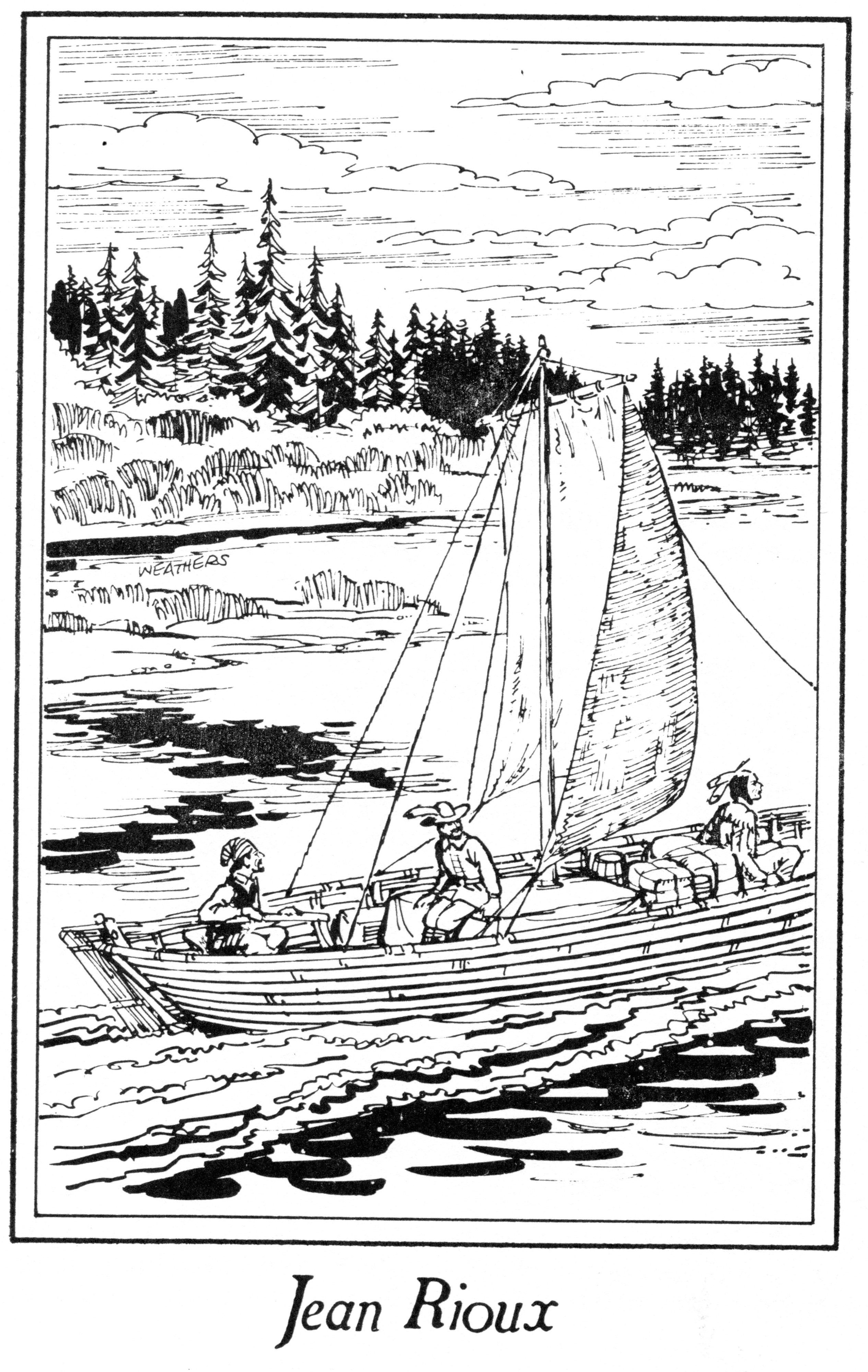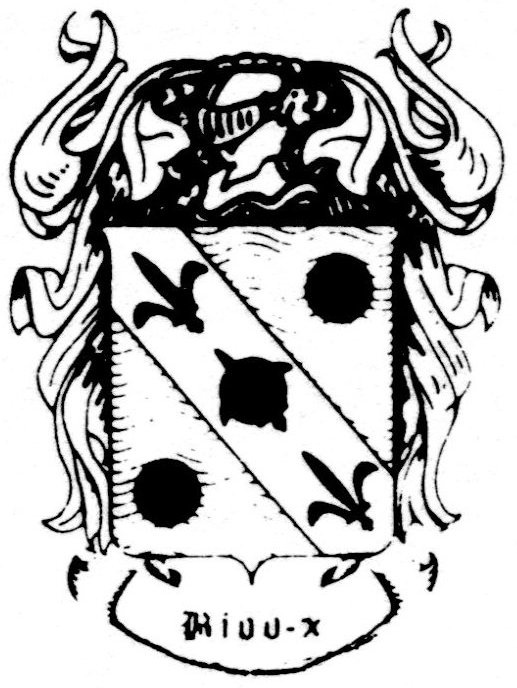
English French/Français Home/Accueil Contact
Jean Riou Early History
The following is from "Nos Ancêtres Québec, Volume 2, Biographie d'Ancêtres", Sainte-Anne-de-Beaupré, C. P. 1000, Sainte-Anne-deBeaupré, Québec, Canada, G0A 3C0, 1981, ISBN 2-89238-233-5, pages 159-165.

Three people named Rioux lived in Canada in the seventeenth century.
Madeleine Rioult, a Norman woman from Notre-Dame-de-la-Ronde, married Louis Lavallée in Québec City, September 10, 1673. She left no descendants.
Jean Riout, 8 March 1669, aged about 17, "native of the city of Rouen", son of Pierre, committed himself for 8 years to the service of the ancestor Jean Routier, parish of Sillery. Peas, we lose its trace.
The ancestor of the Rioux of America, Jean, was originally from Ploujean, diocese of Tréquier, a small locality located on the east bank of the bay of Morlaix, in Brittany. His father, a laborer, bore the same name; his mother was Marguerite Guinguen. Jean had been baptized on March 20, 1652, under the patronymic Roc’hiou. We find him for the first time in Canada, on December 26, 1677, as a "commitment of 21 years", having his contract of marriage written under private signature.
Family Organization
Jean Riou frequented Catherine, daughter of the late Nicolas Leblond, of Île d'Orléans. She had just turned 13. They received the nuptial benediction on January 10, 1678, at Sainte-Famille.
Here is the extract from the register of Sainte-Famille,I.0.: "In the year of
grace one thousand six hundred and seventy eight on the tenth day of January
after the wedding and the publication of the three marriage banns made the
twenty-first, twenty-sixth, and twenty-eighth days of December at the parish
masses of the Church of the Sainte-Famille in Île St. Laurent, between Jean Riou
son of Jean Riou and Marguerite Guinguen his father and mother of the parish of
Ploujas Evesché de Treguier in Brittany, on the one hand, and Catherine le Blond
daughter of the late nicolas le Blond, and Marguerite le Cler, her father and
mother of the parish of Ste. Famille Evesché of Québeq on the other hand.
And there was no legitimate impasse. I, the undersigned priest missionary,
had them in the ditte Church, solemnly interviewed, and after receiving their
mutual consent, gave them the nuptial blessing in the presence of the known
witnesses Vincent Chrestien, Mathurin Gerber, David Asselin and Bernard Lainé.
Ch. A. Martin.
Note that Abbé Charles-Amador Martin (1648-1711), 2nd priest born in Canada, was
the son of Abraham Martin, who left his name at the Plains of Abraham in Québec
City, and Marguerite Langlois.
After two months of marriage, on March 7, the mother-in-law and the son-in-law called on the notary Claude Auber to change their situation before the law. In a first agreement, Jean had promised to remain with his mother-in-law for four years "to serve her on his land and habitation and all similar things." In return Marguerite Leclerc was committed to feeding, dressing her son-in-law, his wife and children to come. After this probation period, the Riou family would have been entitled to a house worth 300 pounds, two oxen, two cows, and farm implements.
The new contract abolished these conditions. Jean and Catherine were married in community of goods. The mother-in-law gave her daughter clothes for a sum of 110 livres, not counting the old coat estimated at five livres; to his son-in-law, six bunches of wheat, and twenty-five pounds to be taken from M. Martin.
It is known that on September 8, the widow Leblond convoluted with Jean Rabouin, father of two children. The inventory of the Norman Nicolas Leblond was drawn up on 23 February 1679, before the notary Vachon. Jean and his wife had to find lodgings elsewhere.
Later, August 3, 1693, Jean will buy from his brother-in-law Nicolas Leroy residing "aladurantaye" the seventh part of the ancestral land of his wife for the sum of 300 books.
A home away from home.
Jean Riou made his way to the lirnites of the present parish of Saint-Frarnçois, I.0., on the north side. On the opposite bank, he could see the first stone church of Sainte-Anne, built since 1676. On February 23, 1679, Pierre Buteau and Perrette Loriot sold him their land. The couple Riou settled there for almost 20 years. Their neighbors were Vincent Chrétien, Nicolas Veilleux and Louis Martineau.
They set to work. On the 28th of the same month, Jean signed a lease. He promised to plow the land of Pierre Buteau - was it the same farm he had just bought? - to sow, to reap, to beat and to win the grapes which he will harvest there for 23 minots of wheat and 1 French corn (of peas) to be delivered to the lessor. Rarely, a skeleton of lawyers attended the contract: Étienne Jacob, Nicolas Métru and Paul Vachon.
On the following August 2nd, at Québec, Jean mortgaged his land by 3 arpents in front by borrowing 59 livres 10 sols from Jean Baillé, which he would have to remit after three years.
And on the 21st of October before noon, in the presence of Becquet, Jean acknowledged having received from Christophe Martin, Sieur de Boiscomeau, the sum of 60 livres which François Berthelot gave to the inhabitants who married and settled on Île d'Orléans.
On December 10, 1679, another contract was signed between Élie Jean, dit Godon, and Jean Riou.
In 1681, Jean Riou told the enumerator to have 15 arpents of land in cultivation.
The Barque Sainte-Anne
On October 3, 1684, Jean Riou and Sébastien Cotleau became co-owners of a boat called La Sainte-Anne. The latter was undividedly owned by Jean Picart, Québec merchant, and Pierre Moisan, with anchors, sails, cables and other maneuvers. The seller Picard will deliver it at the end of the season of navigation in winter place by Nicolas Veilleux "who orders it to the third party". The seller accepted the risks until that time. Price of the transaction: 125 pounds. The purchasers will pay one-third in cash at the next Saint-Martin and the other two at the Magdeleine. Hippolyte Thibierge and Jacques Turet signed as witnesses before the notary Becquet. Riou could not sign.
A small vessel could be used to carry passengers, to fish or to coast. We do not know what precise uses served the Sainte-Anne boat.
Farm lease
In the autumn of 1686, October 7, Jean Riou rented a farm of René Baucheé for 5 years from the following April 1, farm located on the north side of the island, 8 arpents front with good meadows but without building. The neighbors were the heirs of Jean Cotleau and Robert Coustard. The lessor will pay the cens and the seigneurial rents and the tenant will pay 25 bundles of wheat "wheat of the best", annually. Timothée Roussel with H. Thibierge attended as witnesses before Duquet.
In 1688, July 25, François Berthelot made a new concession to Jean Riou. I have not been able to verify the contents of this contract.
Lord of Trois-Pistoles
The seigniory of the Trois-Pistoles had been granted to M. Charles Denys de Vitre, on the 6th of May, 1687, by M. de Denonville. This seigneury, two leagues in front, on the river east of the river, and two leagues deep in the land, also included the neighboring islands like the Basque Island. On March 15, 1696, Jean Riou and his wife gave up their land on Île d'Orléans, which was close to that of Vincent Chrétien and another belonging to Riou, in the parish of Saint-François. This farmhouse had a log house of 36 feet long logs, a barn and a barn with a total length of 54 feet, 2 oxen of 4 years, 2 cows, 2 young pigs, 6 hens and 1 cock. Riou reserved the right to live on his farm on the island until April 1697, paying 40 bunches of wheat.
Our ancestor was not a lord of the drawing-room. The following year, he gave credit and tribute to his Majesty represented at Québec by the Governor and his advisers. One writer, André, wrote to him a text signed by Bochart Champigny, April 10, 1697. The writing specifies that Jean was dispensed from appearing in person at the Chateau Saint-Louis, "for this time only."
Small famine, great offspring
Jean Riou was the father of eight children, two of whom died in the cradle. Two descendants secured his numerous descendants: Nicolas, the eldest, heir to half of his father's lordship, married M. Louise Asselin, October 13, 1710, Sainte-Famille, I.0 .; Vincent unites his life to Catherine Côté, August 20, 1731, in Rimouski.
A daughter, the younger, Marie-Madeleine, probably born at Trois-Pistoles in 1698, became a nun at the Hôtel-Dieu in Québec City where she entered on September 17, 1718. Sister Veronique is rightly the first consecrated soul of Trois-Pistoles and his lineage. She died in Québec City in 1744, October 13th.
The registers of Trois-Pistoles were opened on September 13, 1713, by the inscription of the baptism of a granddaughter of the ancestor, Catherine, daughter of Nicolas. But the act of burial of the husbands Riou, written before 1713 by a missionary of passage, was lost, it seems.
The first priest Rioux was Julien, 6th generation, son of Julien and Scholastique Larrivé. Born in Trois-Pistoles, he studied at Sainte-Anne-de-la-Pocatière and was ordained a priest in New Brunswick, at Shediac, August 4, 1839, according to Bishop Tanguay. He first worked in the Maritimes: Richibouctou, Bouctouche (Pointe-à-Jacquet) and Cocagne. He was later named to various cures including that of Petite Riviere in Charlevoix (1861-1872). He died at Trois-Pistoles, at the age of 85 years.
All the Rioux of America descend from the humble lord Jean, son of the Breton laborer of Ploujean.
BIBLIOGRAPHY
Greffe Adhémar, 10 December 1679.
Greffe Auber, 7 March 1678.
Greffe Becquet, 8 March 1669; 12 October 1679.
Greffe Chambalon, 3 August 1693; 15 March 1696: 22 March 1696; 14 March 1697.
Greffe Duquet. 3 October 1684: 7 October 1686.
Greffe Rageot, 2 August 1679: 24 June 1686.
Greffe Vachon, 28 February 1679: 25 July 1688.
Drouin, Gabriel, Dictlonnaire National des Canadiens-Français (1965), vol. 3, pp. 1852-1853.
Fournier, Marcel, Dictionnaire Biographique des Bretons en NouvelleFrance (1982), p. 119. Marcel Fournier asserts that Jean Riou arrived in Canada as sergeant of a Navy company ... that he was hospitalized at the Hôtel-Dieu in Québec City for 22 days, starting January 1, 1692.
Juchereau & Duplessis, Les Annales de l'Hôtel-Dieu de Québec (1939), pp. 404, 408.
Lafontaine, André, Recensement annoté de la Nouvelle-France 1681 (1981), p. 275.
Roy, P.-G., Archives de la Province de Québec (1928), Inventaire des Concessions en Fief et Seigneurie, Fois et Hommages, etc., vol. IV, p. 5.
Tanguay, Cyprien, Répertoire Général du Clergé Canadien (1893). p. 227.
Bulletin des Recherches Historiques, vol. 4, p. 52; vol. 2, p. 309; vol. 17, pp. 239-240; vol. 18, p. 181; vol. 24, pp. 233-234.
Dictionnaire Biographique du Canada, vol. II, p. 187.
Mémoires de la Société Généalogique Canadienne-Française, vol. 2, pp. 69-70.
Rapport des Archives Nationales du Québec, vol. 2, p. 378: vol. 6, p. 335; vol. 51, pp. 140-144.
